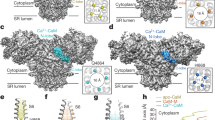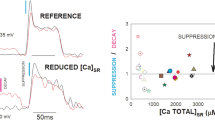Abstract
The association of an endogenous, Ca2+-dependent cysteine-protease with the junctional sarcoplasmic reticulum (SR) is demonstrated. The activity of this protease is strongly stimulated by dithiothreitol (DTT), cysteine and β-mercaptoethanol, and is inhibited by iodoacetamide, mercuric chloride and leupeptin, but not by PMSF. The activity of this thiol-protease is dependent on Ca2+ with half-maximal activity obtained at 0.1 μm and maximal activity at 10 μm. Mg2+ is also an activator of this enzyme (CI50=22 μm). These observations, together with the neutral pH optima and inhibition by the calpain I inhibitor, suggest that this enzyme is of calpain I type.
This protease specifically cleaves the ryanodine receptor monomer (510 kD) at one site to produce two fragments with apparent molecular masses of 375 and 150 kD. The proteolytic fragments remain associated as shown by purification of the cleaved ryanodine receptor. The calpain binding site is identified as a PEST (proline, glutamic acid, serine, threonine-rich) region in the amino acid sequence GTPGGTPQPGVE, at positions 1356–1367 of the RyR and the cleavage site, the calmodulin binding site, at residues 1383–1400. The RyR cleavage by the Ca2+-dependent thiol-protease is prevented in the presence of ATP (1–5 mm) and by high NaCl concentrations. This cleavage of the RyR has no effect on ryanodine binding activity but stimulates Ca2+ efflux. A possible involvement of this specific cleavage of the RyR/Ca2+ release channel in the control of calpain activity is discussed.
Similar content being viewed by others
References
Aebersold, R.H., Leavitt, J., Saavedra, R.A., Hood, L.E., Kent, S.B.H. 1987. Internal amino acid sequence analysis of proteins separated by one- or two-dimensional gel electrophoresis after in situ protease digestion on nitrocellulose. Proc. Natl. Acad. Sci. USA 84:6970–6974
Brandt, N.R., Caswell, A.H., Brandt, T., Brew, K., Mellgren, R.L. 1992. Mapping of the calpain proteolysis products of the junctional foot protein of the skeletal muscle triad junction. J. Membrane Biol. 127:35–47
Busch, W.A., Stromer, M.A., Goll, D.E., Suzuki, A. 1972. Ca2+ specific removal of Z-lines from rabbit skeletal muscle. J. Cell Biol. 52:367–381
Caswell, A.H., Lau, Y.H., Brunschwig, J.P. 1976. Ouabain-binding vesicles from skeletal muscle. Arch. Biochem. Biophys. 176:417–430
Dayton, W.R., Reville, W.J., Goll, D.E., Stromer, M.A. 1976. A Ca2+-activated protease possible involvement in myofibrillar protein turnover. Partial characterization of the purified enzyme. Biochemistry 15:2159–2167
Dayton, W.R., Schollmeyer, J.V., Lepley, R.A., Cortes, L.R. 1981. A calcium-activated protease possibly involved in myofibrillar protein turnover. Biochim. Biophys. Acta 659:48–61
DeMartino, G.N., Blumenthal, D.K. 1982. Identification and partial purification of a factor that stimulates calcium-dependent protease. Biochemistry 21:4297–4303
Fabiato, A. 1988. Computer programs for calculating total from specified free or free from specified total ionic concentrations in aqueous solutions containing multiple metals and ligands. Methods. Enzymol. 157:378–417
Gopalakrishan, R., Barsky, S.H. 1986. Hydrophobic association of calpains with subcellular organs compartmentalization of calpains and the endogenous inhibitor calpastatin in tissues. J. Biol. Chem. 261:13936–13942
Guroff, G. 1964. A neutral, calcium-activated protease from soluble fraction of rat brain. J. Biol. Chem. 239:149–155
Hewick, R.M., Hunkapiller, M.W., Hood, L.E., Dreyer, W.J. 1981. A gas-liquid solid phase peptide and protein sequenator. J. Biol. Chem. 256:7990–7997
Inomata, M., Hayashi, M., Nakamura, M., Imahori, K., Kawashima, S. 1983. Purification and characterization of a calciumactivated neutral protease from rabbit skeletal muscle which requires calcium ions of μm order of concentration. J. Biochem. 93:291–294
Kaplan, R.S., Pedersen, F.L. 1985. Determination of microgram quantities of protein in the presence of milligrams level of lipid with amido black 10B. Anal. Biochem. 150:95–104
Kar, N.C., Pearson, C.M. 1976. A calcium-activated neutral protease in normal and dystrophic human muscle. Clin. Chim. Acta 73:293–298
Kay, J. 1984. Ca2+-activated proteases, protein degradation and muscular dystrophy. In: Proteases: Potential Role in Health and Disease (W.H. Hörl, and A. Heidland), editors, pp. 519–532. Plenum, New York
Laemmli, U.K. 1970. Cleavage of structural proteins during the assembly of the head of bacteriophage T4. Nature 227:680–685
Lai, F.A., Erickson, H.P., Rousseau, E., Liu, Q.Y., Meissner, G. 1988. Purification and reconstitution of the calcium release channel from skeletal muscle. Nature 331:315–319
Lane, R.D., Mellger, R.L., Mericle, M.T. 1985. Subcellular localization of bovine heart calcium-dependent protease inhibitor. J. Mol. Cell. Cardiol. 17:863–872
Lowry, O.H., Rosenbrough, N.J., Farr, A.L., Randall, R.J. 1951. Protein measurements with folin phenol reagent. J. Biol. Chem. 193:265–275
Mellgren, R.L. 1980. Canine cardiac calcium-dependent proteases: Resolution of two forms with different requirements for calcium. FEBS Lett. 109:129–133
Mellgren, R.L. 1987. Calcium-dependent protease: an enzyme system active at cellular membranes. FASEB J. 1:110–115
Mellgren, R.L., Lane, R.D., Kakar, S.S. 1987. Isolated bovine myocardial sarcolemma and sarcoplasmic reticulum vesicles contain tightly bound calcium dependent protease inhibitor. Biochem. Biophys. Res. Commun. 142:1025–1031
Murachi, T. 1983. Calpain and calpastatine. Trends Biochem. Sci. 8:167–169
Murachi, T., Tanaka, K., Hatanaka, M., Murakami, T. 1981. Intracellular Ca2+-dependent protease (calpain) and its highmolecular weight endogenous inhibitor (calpastatin). Adv. Enzyme Regul. 19:407–424
Nelson, W.J., Traub, P. 1982. Purification and further characterization of the Ca2+-activated proteinase specific for the intermediate filament proteins vimentin and desmim. J. Biol. Chem. 257:5544–5553
Pontremoli, S., Melloni, E. 1986. Extralysosomal protein degradation. Annu. Rev. Biochem. 55:455–481
Puca, G.A., Nola, E., Sica, V., Bresciani, F. 1977. Estragon binding proteins of calf uterus; molecular and functional characterization of the receptor transforming factor: A calcium-activated protease. J. Biol. Chem. 252:1358–1370
Rardon, D.P., Cefali, D.C., Mitchell, R.D., Seiler, S.M., Hathaway, D.R., Jones, L.R. 1990. Digestion of cardiac and skeletal muscle junctional sarcoplasmic reticulum vesicles with calpain II: Effect on the Ca2+ release channel. Circ. Res. 67:84–96
Reddy, M.K., Etlinger, J.D., Rabinowitz, M., Fishman, D., Zak, R. 1975. Removal of Z-lines and α-actinin from isolated myofibrils by a calcium-activated neutral protease. J. Biol. Chem. 250:4278–4284
Rogers, S., Wells, R., Rechsteiner, M. 1986. Amino acid sequences common to rapidly degraded proteins: the pest hypothesis. Science 234:364–368
Saito, A., Seiler, S., Chu, A., Fleischer, S. 1984. Preparation and morphology of sarcoplasmic reticulum terminal cisternae from rabbit skeletal muscle. J. Cell Biol. 99:875–885
Seiler, S., Wegener, A.D., Whang, D.D., Hathaway, D.R., Jones, L.R. 1984. High molecular weight proteins in cardiac and skeletal muscle junctional sarcoplasmic reticulum vesicles bind calmodulin, are phosphorylated, and are degraded by Ca2+-activated protease. J. Biol. Chem. 259:8550–8557
Shoshan-Barmatz, V., Zarka, A. 1992. A simple, fast, one-step method for purification of the skeletal muscle ryanodine receptor. Biochem. J. 285:61–64
Suzuki, K. 1987. Calcium activated neutral protease: domain structure and activity regulation. Trends Biochem. Sci. 12:103–105
Takeshima, H., Nishimura, S., Matsumoto, T., Ishida, H.T., Kangawa, K., Minamino, N., Matsuo, H., Ueda, M., Hanaoka, M., Hirose, T., Numa, S. 1989. Primary structure and expression from complementary DNA of skeletal muscle ryanodine receptor. Nature 339:439–445
Towbin, H., Staehelin, T., Gordon, J. 1979. Electrophoretic transfer of proteins from polyacrylamide gels to nitrocellulose sheets: Procedure and some applications. Proc. Natl. Acad. Sci. USA 76:4350–4354
Vedeckis, W.V., Freeman, M.R., Schrader, W.T., O'Malley, B.W. 1980. Progesterone-binding components of chick oviduct: Partial purification and characterization of a calcium-activated protease which hydrolyzes the progesterone receptor. Biochemistry 19:335–343
Wang, K.K.W., Villalobo, A., Roufogalis, B.D. 1989. Calmodulinbinding proteins as calpain substrates. Biochem. J. 262:693–706
Yang, H.-C., Reedy, M.M., Burke, C.L., Strasburg, G.M. 1994. Calmodulin interaction with the skeletal muscle sarcoplasmic reticulum calcium channel protein. Biochemistry 33:518–525
Yoshimura, N., Kikuchi, T., Sasaki, T., Kitahara, A., Hatanaka, M., Murachi, T. 1983. Two distinct Ca2+ proteases (calpain I and calpain II) purified concurrently by the same method from rat kidney. J. Biol. Chem. 258:8883–8889
Zarka, A., Shoshan-Barmatz, V. 1993. Characterization and photoaffinity labeling of the ATP binding site of the ryanodine receptor from skeletal muscle. Eur. J. Biochem. 213:147–154
Zarzato, F., Fuyjii, J., Otsu, K., Phillips, M., Green, N.M., Lai, F.A., Meissner, G., MacLennan, D.H. 1990. Molecular cloning of cDNA encoding human and rabbit forms of Ca2+ release channel (Ry-Rec) of skeletal muscle sarcoplasmic reticulum. J. Biol. Chem. 265:2244–2256
Author information
Authors and Affiliations
Additional information
The work was supported by grants from the fund for basic research administered by the Israeli Academy of Science and Humanities (to V.SB.) and by Funds from the Minister für Wissenschaft und Forschüng des Landes NRW, from the fonds der Chemischen Indüstrie, from the Deütsche Forschungsgemeinschaft and the Minister für Arbeit Gesündheit ünd Soziales des landes NRW via Herzzentrüm Bad Oeynhaüsen (to the German group). We thank Prof. J. Abramson, Portland State University, for reading the manuscript and offering helpful discussions and valuable suggestions. We also thank Mr. B. Koppitz for technical assistance and Mr. G. Raziel for the photographs.
Rights and permissions
About this article
Cite this article
Shoshan-Barmatz, V., Weil, S., Meyer, H. et al. Endogenous, Ca2+-dependent cysteine-protease cleaves specifically the ryanodine receptor/Ca2+ release channel in skeletal muscle. J. Membarin Biol. 142, 281–288 (1994). https://doi.org/10.1007/BF00233435
Received:
Revised:
Issue Date:
DOI: https://doi.org/10.1007/BF00233435




